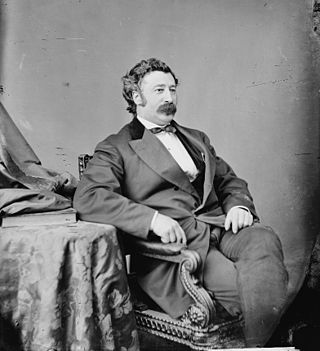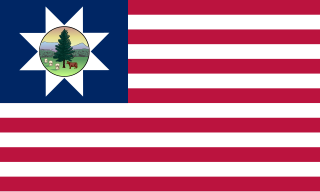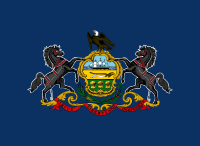Service
This regiment was organized at Philadelphia and mustered into federal service on May 1, 1861. This regiment, composed mainly of men of Irish descent, was the outgrowth of a Philadelphia militia regiment and was recruited in that city, with the exception of one company from Wilmington, Del.
After mustering in, it went into camp near Philadelphia, the men being treated well by the city's people. The regiment then proceeded to Hagerstown, via Chambersburg, and arrived at Camp Porter on June 22, where it was assigned to the 5th Brigade, 2nd Division. It took part in the maneuvers near Martinsburg, Bunker Hill and Charlestown. On July 27, Major General Robert Patterson [note 1] asked the regiment to remain on duty until the replacing regiments arrived. On August 9, the regiment moved to Harper's Ferry. The next day it entrained for Baltimore and arrived in Philadelphia in the afternoon. It was mustered out at Philadelphia, on August 10, 1861, having remained in the service two weeks longer than the term of enlistment..
List of battles
The regiment participated in no battles during its service.
Detailed service
- Left Philadelphia for Chambersburg, PA, on June 3
- Attached to Patterson's Army, June 3
- Moved to Hagerstown, MD, June 16
- Moved to Williamsport, MD June 18
- Garrisoned Camp Porter, June 22
- Occupied Martinsburg, VA July 3
- Advanced on Bunker Hill July 15
- At Charlestown, VA July 17
- Moved to Harper's Ferry, VA August 9
- Moved to Philadelphia and mustered out August 10, 1861.

James Scott Negley was an American Civil War General, farmer, railroader, and U.S. Representative from the state of Pennsylvania. He played a key role in the Union victory at the Battle of Stones River.

The 1st Vermont Infantry Regiment was a three months' infantry regiment in the Union Army during the American Civil War. It served in the eastern theater, in and around Fortress Monroe, Virginia.
The 6th New Jersey Infantry Regiment was regiment of infantry from New Jersey that served in the Army of the Potomac during the American Civil War.
The 6th Indiana Infantry Regiment was an infantry regiment from the State of Indiana that served in the Union Army during the American Civil War. This regiment was the senior Indiana regiment of the Civil War, as it was numbered first in sequence after the five Indiana volunteer regiments which had served in the Mexican–American War. The regiment was originally mustered-in for a three-month period of service between April and August 1861, but after its initial term of service had expired it was re-formed in September 1861 for a further three-year period, before being mustered out in September 1864.
The 7th Regiment Indiana Volunteer Infantry was an infantry regiment from the State of Indiana that served in the Union Army during the American Civil War.
The 78th Pennsylvania Volunteer Infantry was an infantry regiment that served in the Union Army during the American Civil War.

The 2nd Regiment Massachusetts Volunteer Infantry was an infantry regiment in the Union Army during the American Civil War. Major George H. Gordon, a West Point graduate and veteran of the Mexican–American War, organized the unit's recruitment and formation. The 2nd Massachusetts was trained at Camp Andrew in West Roxbury, Massachusetts on the site of the former Transcendentalist utopian community, Brook Farm. Roughly half the regiment was mustered in on May 18, 1861 and the remainder on May 25, 1861 for a term of three years. The regiment saw extensive combat as part of the Army of the Potomac particularly during the Battle of Antietam and the Battle of Gettysburg.
The 175th Ohio Infantry Regiment, sometimes 175th Ohio Volunteer Infantry was an infantry regiment in the Union Army during the American Civil War.
The 164th Ohio Infantry Regiment, sometimes 164th Ohio Volunteer Infantry was an infantry regiment in the Union Army during the American Civil War.
Turner Gustavus Morehead (1814–1892) was an officer in the Mexican–American War and American Civil War and Brevet Brigadier General in the Union Army.
The 63rd Pennsylvania Volunteer Infantry was an infantry regiment that served in the Union Army during the American Civil War.

The 4th Pennsylvania Infantry Regiment, officially known as the 4th Regiment, Pennsylvania Volunteer Infantry, was an infantry regiment of the Union Army in the American Civil War. Formed mostly from a militia unit in Norristown in southeastern Pennsylvania, the regiment enlisted at the beginning of the American Civil War in April 1861 for a three-month period of service under the command of Colonel John F. Hartranft. Logistical difficulties bedeviled the regiment, which served as part of the garrison of Washington, D.C., until late June, when it was sent into Northern Virginia to join in the army of Brigadier General Irvin McDowell.

The Reading Artillerists was a militia organization formed in Reading, Pennsylvania during the late 18th century. Mustering in for the first time during the presidential era of George Washington, members of this artillery unit went on to serve tours of duty in the War of 1812, Mexican–American War and, as members of the Union Army during the American Civil War, before later disbanding.

The 12th Regiment Pennsylvania Volunteer Infantry was an infantry regiment of the Union Army in the American Civil War. Raised in Pittsburgh and its surrounding counties in April 1861 for three months of service, the regiment spent its first month in training, then guarded the Northern Central Railway in Maryland until it was mustered out. Many of its men went on to serve in subsequent Pennsylvania regiments during the war.

The 172nd Pennsylvania Infantry was an infantry regiment in the Union Army during the American Civil War.

The 5th New York State Militia was a New York State militia, organized in 1861 in New York City, under Colonel C. Schwarzwaelder, Lieutenant Colonel Louis Burger and Major George Van Amsberg. The regiment's primary language was German. It offered its services to the state on 16 April 1861. Although the regiment was originally organized as artillery, it was assigned to the infantry.

The 22nd Pennsylvania Volunteer Infantry was a three-month infantry regiment that served in the Union Army during the American Civil War.

The 21st Pennsylvania Volunteer Infantry was a three-month infantry regiment that served in the Union Army during the American Civil War.

The 19th Pennsylvania Volunteer Infantry was a three-month infantry regiment that served in the Union Army during the American Civil War.

The 3rd Pennsylvania Infantry was an infantry regiment in the Union Army during the American Civil War that served for three months at the beginning of the war.
This page is based on this
Wikipedia article Text is available under the
CC BY-SA 4.0 license; additional terms may apply.
Images, videos and audio are available under their respective licenses.









